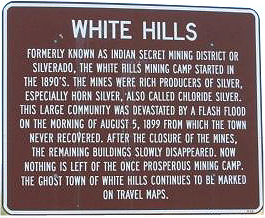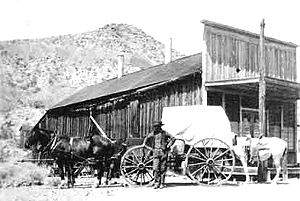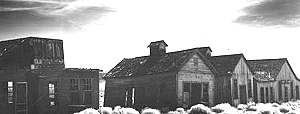| Formerly known as Indian Secret Mining District or Silverado, the White Hills Mining Camp started in the 1890's. The mines were rich producers of silver, especially horn silver, also called chloride silver.
 White Hills began inauspiciously when a Hualapai Indian cowboy who went by the name of Jeff, was off-handedly asked by Judge Henry Schaeffer “if he knew of any good mine prospect.” Hualapai Jeff was on his way toward the head of the canyon (now camp White Hills) in search of paint that he had been told existed in that neighborhood. White Hills began inauspiciously when a Hualapai Indian cowboy who went by the name of Jeff, was off-handedly asked by Judge Henry Schaeffer “if he knew of any good mine prospect.” Hualapai Jeff was on his way toward the head of the canyon (now camp White Hills) in search of paint that he had been told existed in that neighborhood.
He found both, the paint (oxide of iron) and a fine specimen of chloride of silver. He thought the specimen was worth keeping but was told it was just iron ore with no value, so Jeff paid no more attention to his find.
As usual, three men came along and staked the following claims: Horn Silver, Occident, Grand Army (of the Republic), Chief of the Hills, Treasurer, Norma and Emma. These three men formed a partnership, excluding Jeff. The Judge told everyone in July 1892 that no Indian was involved, that he found the original float years previous, and had spent that time since searching for it.
 A few men gathered in a general store, debated and chose White Hills as the name for the new camp, versus Indian Secret or Schaefferville. A latecomer M. L. Vail, went to Prescott for a photographer, and mentioned to the local newspaper it should have been named “Silverado.” A few men gathered in a general store, debated and chose White Hills as the name for the new camp, versus Indian Secret or Schaefferville. A latecomer M. L. Vail, went to Prescott for a photographer, and mentioned to the local newspaper it should have been named “Silverado.”
Countless buildings were erected - homes, a school, stores, laundries and 12 saloons (7 in a row on Main Street). A post office came into being October 20, 1892 to be discontinued August 1914.
 The rich shipments caught the attention of David Moffat, noted mining man of Denver, Colorado. He sent D. T. Root to investigate and in August 1893 Moffat and Root had consolidated most of the claims into one property under “White Hills Mining Company.” The rich shipments caught the attention of David Moffat, noted mining man of Denver, Colorado. He sent D. T. Root to investigate and in August 1893 Moffat and Root had consolidated most of the claims into one property under “White Hills Mining Company.”
They immediately shipped a ten stamp mill from Denver and had it running early in 1894. At this time 500 men were working on leases, while still more men worked for the company. The mill was successful for two years, and then sold for $1,750,000.
A concrete reservoir of 1,000,000 gallons capacity was built, to hold the springs’ water and White Hills was provided with an up-to-date water supply system, including fire hydrants - which did not work - the gravity was insufficient for operation. An electric plant, $150,000, was constructed.
Despite $12,000,000 in total ore production for the past six years, in 1898 new strikes stopped, and the rich vein paid out. Building ceased and the cost of living soared, so miners and families drifted away.
The large community was devastated by a flash flood on the morning of August 5, 1899 from which the town never recovered. Today there are few memories left, with only a few scattered remains, mining equipment and foundations. In 1972, a mining company commenced exploration, but found not enough to warrant expense of full development.
A street scene from the 1940's shows a lot of decay.  Today, 100 years after the flood, White Hills is considered a ‘true’ Ghost Town of Mohave County. Today, 100 years after the flood, White Hills is considered a ‘true’ Ghost Town of Mohave County.
But hope spring etrenal with new ideas and now area is destined to become a huge houseing devlopment.
The ghost town of White Hills continues to be marked on travel maps.
|